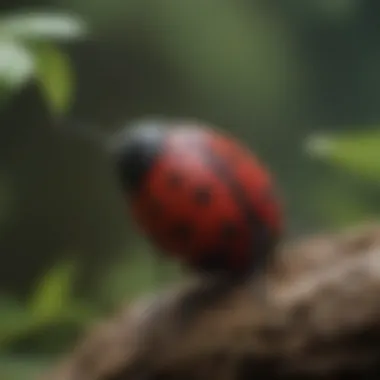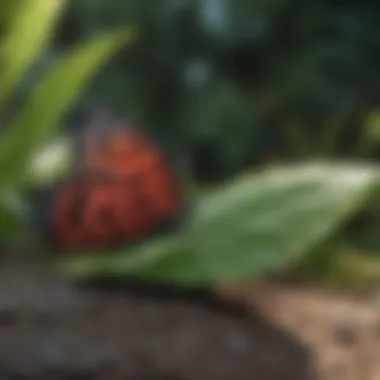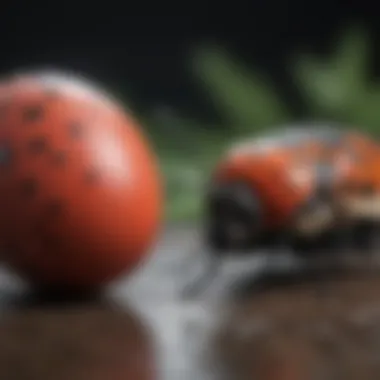Effective Methods to Eliminate Spotted Lanternfly Eggs and Safeguard Plant Life


Animal Species Profile
Spotted lanternflies, a destructive pest species causing harm to vegetation, have become a significant concern for plant life. These insects are characterized by their small size, measuring around one inch in length, and distinct spotted wings. Initially native to parts of Asia, spotted lanternflies have spread to the United States and Europe, posing a threat to various plant species. Their behavior includes clustering in large numbers on trees and plants, where they lay their eggs in masses.
Understanding Spotted Lanternfly Eggs
Spotted Lanternfly eggs are a critical aspect discussed in this article, focusing on the devastation these pests cause to vegetation. By gaining an in-depth understanding of these eggs, readers can effectively combat infestations and protect plant life. Recognizing the appearance, location, and signs of infestation of these eggs is essential for successful pest control.
Appearance of Spotted Lanternfly Eggs
Color and Texture
The color and texture of Spotted Lanternfly eggs play a crucial role in their identification. These eggs exhibit a distinctive mottled gray appearance, blending seamlessly with tree bark to evade detection. Their smooth texture aids in camouflage, making them challenging to spot among foliage. This adaptation enhances the survival chances of the eggs during their incubation period.
Location on Plants
Spotted Lanternfly eggs are typically laid on smooth surfaces such as tree bark or plant stems. The choice of location is strategic, providing protection from predators and harsh weather conditions. By being attached to plants, these eggs secure a vital food source for the emerging nymphs, ensuring their survival. Understanding this specific characteristic aids in targeted detection and removal of egg masses.
Signs of Infestation
Wilting Plants
One of the prominent signs of a Spotted Lanternfly infestation is the wilting of plants. As these pests feed on plant sap, they weaken the host plant, leading to wilting and eventually its demise. By identifying plant wilt early on, intervention strategies can be implemented to prevent further damage to vegetation.
Honeydew Deposits
Presence of honeydew deposits on plants is another indicator of a Spotted Lanternfly infestation. These sugary secretions not only attract ants and other pests but also promote the growth of sooty mold, affecting plant health. Monitoring for honeydew deposits aids in the early detection of infestations, allowing for timely action to be taken to eliminate the pests.


Identifying Spotted Lanternfly Egg Masses
In the realm of combating the spotted lanternfly and safeguarding plant life, the identification of their egg masses stands paramount. This facet of the article delves into the crucial task of spotting these miniature threats before they hatch and wreak havoc. By honing the skill of distinguishing lanternfly egg masses from benign structures, individuals can proactively preserve their local flora and mitigate infestation risks. The meticulous inspection and identification of these egg masses form the bedrock of effective pest management strategies.
Visual Characteristics
Sleek Appearance
The sleek appearance of spotted lanternfly egg masses encapsulates a streamlined aesthetic that sets them apart from their surroundings. This characteristic plays a pivotal role in the detection process, enabling vigilant observers to pinpoint these camouflaged threats amidst foliage. The glossy surface of the eggs reflects light uniquely, aiding in their recognition even in dimly lit environments. This sleek quality lends a deceptive elegance to the eggs, making them blend seamlessly with tree bark or plant stems. However, this very trait also acts as a double-edged sword, requiring a keen eye to discern these eggs from natural surface variations.
Squished Appearance
Contrasting with the sleek variant, some spotted lanternfly egg masses exhibit a squished appearance due to pressure during oviposition. This irregular contouring sets them apart from the uniformity of surrounding textures, serving as a clue for detection. The flat sides of these squished eggs create a distinct profile that enhances visibility, aiding in their identification during thorough inspections. While this deformation may make them more conspicuous, it also adds to the challenge of differentiating them from nontoxic blemishes on plant bark. Embracing a discerning approach is thus imperative in accurately singling out these squished egg masses amidst natural imperfections.
Tactics for Detection
Surveying Trunks and Branches
The technique of surveying trunks and branches emerges as a fundamental strategy in the quest to detect spotted lanternfly egg masses. By systematically canvassing tree surfaces and foliage, individuals increase their chances of discovering these cryptic threats concealed in plain sight. The close scrutiny of bark patterns and branch crevices unveils the eggs' clandestine placements, unveiling potential infestation sites. Tireless tree inspections allow for early interception, preventing the eggs from hatching and launching a destructive invasion. Despite its efficacy, this method demands patience and thoroughness to cover every nook and cranny where these egg masses might lurk.
Using Magnifying Tools
Integrating magnifying tools into the detection process elevates precision and amplifies the visibility of spotted lanternfly eggs. Leveraging magnifiers or magnifying glasses enhances the minutiae observed during inspections, making subtle differences in egg textures more discernible. The amplified view provided by these tools facilitates the identification of sleek or squished egg masses, even in intricate plant structures. While magnification aids in accurate detection, it also necessitates a steady hand and focused attention to avoid overlooking these miniature threats. Embracing magnifying tools enriches the detection experience, unveiling the hidden world of spotted lanternfly eggs with intricate clarity.
Safe Removal Procedures
Safe removal procedures are crucial in the battle against spotted lanternfly eggs infestation. By effectively addressing the removal of these eggs, we can prevent widespread damage to vegetation. One must handle this task with precision and care to ensure the eradication of the threat. Understanding the safe removal procedures outlined in this article is essential for safeguarding plant life and curbing infestation risks.
Manual Extraction Techniques


Scraping with Tools
Scraping with tools is a meticulous process where specialized instruments are used to gently remove spotted lanternfly eggs from surfaces. This technique allows for targeted and thorough extraction, minimizing the chances of missing any eggs. The key characteristic of scraping with tools lies in its precision and efficiency. It is a popular choice due to its effectiveness in removing eggs without causing damage to plants, making it an ideal method for this article. The unique feature of scraping with tools is its ability to be tailored to different surfaces, ensuring a comprehensive removal process. While this technique requires patience and attention to detail, its advantages in eliminating spotted lanternfly eggs are paramount in ensuring plant health.
Drowning in Soapy Water
Drowning spotted lanternfly eggs in soapy water is a simple yet effective method for their disposal. The key characteristic of this technique is its accessibility and eco-friendliness. Soapy water acts as a suffocating agent for the eggs, ensuring their demise without the use of harmful chemicals. This method is popular for its environmental considerations, as it poses minimal risk to beneficial insects and surrounding flora. The unique feature of drowning in soapy water is its cost-effectiveness and ease of implementation. While there are limitations to this method in terms of scale, its advantages in maintaining ecological balance in the removal process are significant for this article.
Environmental Considerations
Avoiding Harm to Beneficial Insects
Preserving beneficial insects is paramount in any pest control strategy. By avoiding harm to these allies, we can maintain a balanced ecosystem while targeting harmful pests like spotted lanternflies. The key characteristic of this aspect is its focus on sustainable pest management practices. It is a beneficial choice for this article as it aligns with environmentally-conscious approaches to pest control. The unique feature of avoiding harm to beneficial insects is its long-term impact on ecosystem stability, ensuring that natural predators remain unharmed in the removal process. While there may be challenges in implementation, the advantages of this approach in promoting biodiversity and ecological resilience are crucial for this article.
Proper Disposal Methods
Proper disposal methods play a vital role in curbing the resurgence of spotted lanternfly infestations. By adhering to correct disposal practices, we prevent the spread of eggs and minimize environmental impact. The key characteristic of proper disposal methods is their ability to break the lifecycle of the pest effectively. This aspect is crucial for preventing reinfestation and protecting plant life in the long term. The unique feature of proper disposal methods is their contribution to sustainable pest control, ensuring that infestation risks are mitigated through responsible egg disposal. While there may be variations in disposal techniques, the advantages of proper disposal in maintaining a pest-free environment make it a vital component of this article.
Implementing Preventive Measures
In the realm of combating the threat posed by spotted lanternfly eggs, implementing preventive measures emerges as a crucial aspect that demands meticulous attention. The proactive execution of preventive strategies serves as a sturdy shield to safeguard vegetation from the detrimental impact of these invasive pests. By fortifying our defenses through preemptive actions, we can effectively curb the proliferation of the spotted lanternfly population, thereby preserving the ecological balance of our surroundings. Understanding the significance of anticipatory measures lays the foundation for sustainable pest management practices, promoting harmonious coexistence with nature.
Modification of Surroundings
Removing Host Plants
Within the tactics of implementing preventive measures, the removal of host plants emerges as a strategic maneuver that plays a pivotal role in halting the lifecycle of spotted lanternflies. By strategically eliminating host plants that serve as breeding grounds for these pests, we disrupt their reproductive cycle and limit their ability to thrive. The absence of host plants not only impedes the spread of infestation but also creates an inhospitable environment for spotted lanternflies to settle and lay eggs. This deliberate act of depriving them of essential resources is a proactive step towards mitigating the impact of their presence and curbing infestation rates. However, it is essential to consider the potential drawbacks, such as altering the natural landscape and disrupting the ecosystem balance.


Installing Physical Barriers
In parallel to removing host plants, installing physical barriers presents another formidable line of defense against spotted lanternfly infestations. By erecting obstacles that impede the movement of these pests, we thwart their invasion attempts and restrict their access to vulnerable vegetation. Physical barriers act as deterrents, preventing the physical contact between spotted lanternflies and plants, thus reducing the likelihood of egg-laying and infestation. The strategic placement of barriers is instrumental in creating demarcated zones that shield plants from unwanted intrusion, reinforcing the protection of green spaces. While the advantages of physical barriers are evident in their efficacy, it is vital to weigh the trade-offs, such as the labor-intensive installation process and potential visual impact on the landscape.
Chemical Control Options
Neem Oil Applications
Delving into chemical control options, neem oil applications emerge as a prominent choice revered for their eco-friendly properties and efficacy in managing spotted lanternfly populations. The key characteristic of neem oil lies in its natural composition, derived from the neem tree, which not only serves as a potent insecticide but also exhibits minimal harm to beneficial insects. The unique feature of neem oil applications lies in their dual functionality, acting as a deterrent for spotted lanternflies while preserving the ecological balance by safeguarding beneficial insects. The advantages of neem oil applications are underscored by their sustainable nature and low toxicity, ensuring a targeted approach to pest control without causing undue harm to the environment.
Professional Insecticide Treatments
Contrasting neem oil applications, professional insecticide treatments offer a comprehensive solution administered by skilled experts equipped to handle severe infestations with precision. The key characteristic of professional insecticide treatments lies in their tailored approach, customized to address specific infestation levels and mitigate risks effectively. The unique feature of professional treatments is their potency in swiftly eradicating spotted lanternfly populations, providing swift relief to besieged vegetation. While the advantages of professional insecticide treatments are undeniable in their efficacy, it is imperative to acknowledge the potential drawbacks, such as the reliance on chemical agents and the need for expert oversight to ensure safe application and optimal results.
Monitoring for Reappearance
In the battle against the invasive spotted lanternfly eggs, constant vigilance through monitoring for reappearance is crucial. By regularly inspecting your surroundings, you can detect any signs of resurgence early on, preventing widespread infestations. This proactive approach not only safeguards your plants but also aids in the overall conservation efforts against this pest.
Regular Inspection Practices
Seasonal Surveillance
Seasonal surveillance plays a pivotal role in tracking the lifecycle of the spotted lanternfly eggs. This method involves closely monitoring the different seasons for any fluctuations in egg populations. The distinct advantage of seasonal surveillance lies in its ability to pinpoint vulnerable periods when egg-laying activity is at its peak, allowing for targeted eradication measures. However, the challenge lies in the variability of egg hatching times due to environmental factors, requiring adaptability in surveillance strategies.
Early Intervention Strategies
Early intervention strategies are essential in nipping spotted lanternfly infestations in the bud. By promptly addressing any detected eggs or nymphs, you can prevent the escalation of the problem and minimize damage to plant life. The key characteristic of early intervention lies in its proactive nature, focusing on swift action to curtail the spread of the pest. Despite its effectiveness, early intervention may require consistent monitoring and swift responses, demanding continuous dedication and effort.
Community Awareness Initiatives
Community awareness initiatives serve as a powerful tool in the fight against spotted lanternfly eggs infestations, rallying individuals to take collective action in pest management. Educational campaigns are cornerstone elements of raising awareness, providing valuable information on identification and prevention methods. These campaigns not only empower individuals to take proactive measures but also foster a sense of environmental responsibility within the community.
Reporting Infestations
Reporting infestations serves as the backbone of community-driven pest control efforts, ensuring swift responses and targeted interventions. By promptly reporting any sightings or suspected infestations, individuals contribute to a comprehensive database that aids in tracking and managing spotted lanternfly populations. The unique feature of reporting infestations lies in its ability to leverage community knowledge for effective pest control, utilizing collective observations to implement tailored solutions. However, it is essential to streamline reporting processes to encourage widespread participation and timely actions.







